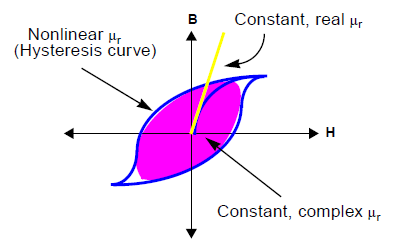Magnetic Loss Tangent
To represent a magnetic material such as ferrite that dissipates the power of a high-frequency magnetic field, enter a magnetic loss tangent, m¢¢/m¢, property value for the material. The smaller the loss tangent, the less lossy the material.
Imaginary Permeability
Eddy Current
Some materials exhibit a permeability that includes both a real and imaginary component. The imaginary component is used to model magnetic losses in a time-varying field using the relationship:

where
 is the real component of the relative permeability.
is the real component of the relative permeability.
 is the imaginary component of the relative permeability.
is the imaginary component of the relative permeability.
 is the permeability of free space.
is the permeability of free space.
As shown below, a complex relative permeability causes the B field to lag behind the H field – similar to the behavior of a nonlinear, lossy material. The power loss during this cycle (the color shaded area) is approximately equal to the hysteresis loss (the area within the blue lines). The hysteresis curve for a material with a constant, real permeability (the straight yellow line) is shown as a reference.

When the nature of losses is also due to magnetic hysteresis, Maxwell allows you to model such effects using complex permeability by allowing the specification of the tangent of magnetic loss. When a linear material exhibits hysteresis effects, it should be characterized using a complex permeability, as below:

where tan d is the magnetic loss tangent, 
Enter the imaginary relative permeability of a material, μ", in the Imag. Permeability field. The default imaginary permeability of zero is that of a material that exhibits no magnetic loss in a time-varying field.
